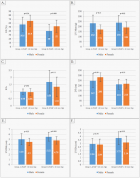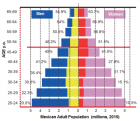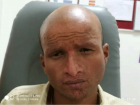Abstract
Research Article
Assessment of Indigenous Knowledge on Using of Traditional Medicinal Plants to Cure Human Diseases in South Omo Zone Baka Dawla Ari District, Kure and Bitsmal South Ethiopia
Gizaw Bejigo*
Published: 30 May, 2024 | Volume 8 - Issue 2 | Pages: 048-054
This ethnobotanical study aims to investigate and document the indigenous knowledge on using traditional medicinal plants to cure human diseases in southern Ethiopia, south Omo zone Baka dawla Ari district at Kure and Bitsmal community. In this study, 77 plant species that belong to 68 genera and 35 plant families were identified by 110 local community members and 10 traditional healers of the study area to treat 32 human diseases. According to the analyzed result of the study three families (Lamiaceae, Solanaceae, and Fabaceae) are equally leading families each with nine species (11.69%) followed by Euphorbiaceae with five species (6.5%) and Asteraceae with four species (5.2%) in the study area. The result of this study also shows that most of the traditional medicines were taken in the mouth (oral) at 61.5% followed by topical (26,4%) and inhalation form (12.1%). The findings of this study show that most traditional plants were collected from the forest (45.5%) followed by the backyard (26%) and herbs are the most popular (59%) followed by shrubs (27%) plant habits. According to the result of this study, leaves are the dominant traditional medicinal plant parts used (55%) followed by roots (11.2%). preference ranking of medicinal plants in the study shows Solanum incanum ranked first indicating that it was the most effective in curing stomach pain followed by Verbena officinalis and the highest informant consensus factor value (0.57) was recorded by Malaria, Evil eye, snake bite, sudden disease categories.
Read Full Article HTML DOI: 10.29328/journal.jpsp.1001132 Cite this Article Read Full Article PDF
Keywords:
Indigenous knowledge; Local community; Traditional healers; Traditional medicinal plants; Omo Zone Baka Dawla Ari
References
- Singh R, Geetanjali. Chapter 6 - Chemotaxonomy of Medicinal Plants: Possibilities and Limitations. Natural Products and Drug Discovery. 2018; 119-136.
- WHO (World Health Organization) Fact Sheet. Traditional Medicine. May 2003, Geneva. WHO. Traditional medicine. 2012. http://www.who.int/mediacentre/factsheets/fs134/en, 2003.
- Cotton CM. Ethnobotany: Principles and Applications. John Wiley and Sons. New York; 1996.
- Hao DC. Ranunculales Medicinal Plants. 2019.
- Pankhrust R. The status and Availability of oral and written Knowledge on traditional health care in Ethiopia. In The National Workshop on Biodiversity Conservation and Sustainable Use of Medicinal Plants in Ethiopia. 2001; 28: 01.
- OKoye TC, Okereke EI. Toxicological survey of African medicinal plants. 2014.
- Moshi MJ, Otieno DF, Mbabazi PK, Weisheit A. The ethnomedicine of the Haya people of Bugabo ward, Kagera Region, north western Tanzania. J Ethnobiol Ethnomed. 2009 Aug 31;5:24. doi: 10.1186/1746-4269-5-24. PMID: 19715617; PMCID: PMC2739164.
- Giday M, Teklehymanot T, Abebe A, Yalemtsehay M. Medicinal plants of Shinasha, Agew-awe and Amhara peoples in northwest Ethiopia. J Ethnopharmaco. 2007; 110: 516-5 25.
- Sori T, Bekana M, Adunha G, Kelbesa F. Medicinal plants in Ethnoveterinary Practices of Borana pastoralists, Southern Ethiopia. International Journal of Applied Research in Veterinary Medicine. 2004; 2: 220-225.
- Fullas F. The role of indigenous medicinal plants in Ethiopia healthcare. African Renaissance. London, UK, 2007.
- Mengistu AK. The Effect of Herbal Preparation on Staphylococcus Aureus and Streptococcus Agalactiae Isolated from clinical bovine mastitis (unpublished MSc thesis Faculty of Veterinary Medicine, AAU), 2004.
- Giday M, Ameni G: An Ethnobotanical Survey on Plants of Veterinary Importance in two Woredas of Southern Tigray, Northern Ethiopia. SINET: Ethiopian Journal of Science. 2003; 26(2):123-136.
- Hamiton AC. Medicinal plants and conservation: Issues and approaches, UK: international plant conservation unit, WWF-UK, pandahoise, Catteshall Lane. 2003.
- Hedberg I, Ensermu K, Edward S, demissew S, Persson E, Gentianacea. In: Flora Ethiopia and Eritrea.The national herbarium Addis Ababa, Ethiopia, and Uppsala, Sweden. 5: 2006.
- Alexiades M. Collecting ethnobotanical data: An introduction to basic concepts and techniques. In: Alexiades M, Sheldon JW, eds. Selected Guidelines for Ethnobotanical Research: A Field Manual. Botanical Garden, New York, NY, USA: PP; 1996; 58-94.
- Heinrich M, Ankl A, Frei B, Weimann C, Sticher O. Medicenal plants Mexico: Healer‟s Consensus and Cultural Importance. Social Science and Medicine. 1998; 47:1863-1875.
- Tefara BN, Kim YD. Ethnobotanical Study of Medicinal Plants in the Hawassa Zuria District, Sidama Zone Southern Ethiopia. 2019. htt://doi.org/10.1186/s 13002-019-0302-730.
- Yineger H, Yewhalaw D. Traditional medicinal plant knowledge and use by local healers in Sekoru District, Jimma Zone, Southwestern Ethiopia. J Ethnobiol Ethnomed. 2007 Jun 4;3:24. doi: 10.1186/1746-4269-3-24. PMID: 17547765; PMCID: PMC1905946.
- Regassa R, Bekele T, Megersa M. Ethnobotanical study of traditional medicinal plants used to treat human ailments by Halaba people, southern Ethiopia. Journal of Medicinal Plant Studies. 2017; 5(4): 36-47.
- Bejigo G, Eribo K. Ethnobotanical study of medicinal plants used to treat human illness in Isara district Gudumo Nada, southern Ethiopia. IJMPR. 2022; 6(2): 18-28.
- Ayyanar M, Ignacimuthu S. Traditional knowledge of Kani tribals in Kouthalai of Tirunelveli hills, Tamil Nadu, India. J Ethnopharmacol. 2005 Nov 14;102(2):246-55. doi: 10.1016/j.jep.2005.06.020. Epub 2005 Jul 28. PMID: 16054791.
- Wassihun B, Asfaw Z, Demissew S. Ethnobotanical Study of Useful Plants in Daniio Gade (Home-Gardens) in Southern Ethiopia. Ethiopian Journal of Biological Science. 2003; 2(2):119-141.
- Bekalo H, Demissew S, Woldematas W, Asfaw Z. An ethnobotanical study of medicinal plants used by local people in the lowlands of Konta Special Woreda, southern nations, nationalities and peoples regional state, Ethiopia. 2009.
- Chekole G. Ethnobotanical study of medicinal plants used against human ailments in Gubalafto District, Northern Ethiopia. Journal of Ethnobiology and Ethnomedicine. 2017; 13:55. DOI: 10.1186/s13002-017-0182-7.
Figures:
Similar Articles
-
Assessment of indigenous methods of shea butter processing among rural women in Borgu Local Government Area of Niger State, NigeriaIbrahim Sani*,Musa Masud. Assessment of indigenous methods of shea butter processing among rural women in Borgu Local Government Area of Niger State, Nigeria. . 2022 doi: 10.29328/journal.jpsp.1001088; 6: 146-150
-
Ethno-Medicinal Plants from the North-Central Western Ghats of India for Alternative Health CarePramod J Hurkadale*, Chaitrali M Bidikar. Ethno-Medicinal Plants from the North-Central Western Ghats of India for Alternative Health Care. . 2023 doi: 10.29328/journal.jpsp.1001109; 7: 076-080
-
Assessment of Indigenous Knowledge on Using of Traditional Medicinal Plants to Cure Human Diseases in South Omo Zone Baka Dawla Ari District, Kure and Bitsmal South EthiopiaGizaw Bejigo*. Assessment of Indigenous Knowledge on Using of Traditional Medicinal Plants to Cure Human Diseases in South Omo Zone Baka Dawla Ari District, Kure and Bitsmal South Ethiopia. . 2024 doi: 10.29328/journal.jpsp.1001132; 8: 048-054
Recently Viewed
-
Parents’ perception of the school nurse’s roleDiane Gillooly*,Ganga Mahat,Patricia Paradiso. Parents’ perception of the school nurse’s role. J Adv Pediatr Child Health. 2020: doi: 10.29328/journal.japch.1001021; 3: 064-067
-
Plant growth, Yield and Leaf Nutritional value of Jute (Corchorus olitorius L.) as Influenced by Banana Peel levels under Salt Stress conditions in Coastal region of CameroonMathias Julien Hand*,Chimène Fanta Abib,Kingsley Mbi Tabi,Alphonse Ervé Nouck,Libert Brice Tonfack,Victor Désiré Taffouo,Emmanuel Youmbi. Plant growth, Yield and Leaf Nutritional value of Jute (Corchorus olitorius L.) as Influenced by Banana Peel levels under Salt Stress conditions in Coastal region of Cameroon. J Plant Sci Phytopathol. 2024: doi: 10.29328/journal.jpsp.1001145; 8: 131-140
-
Dynamics of Siberian Fir Stands in Forest Ecosystems of Eastern Sayan SpursBazhina Elena Vasil’evna*,Pavel I Aminev. Dynamics of Siberian Fir Stands in Forest Ecosystems of Eastern Sayan Spurs. J Plant Sci Phytopathol. 2024: doi: 10.29328/journal.jpsp.1001146; 8: 141-143
-
Minimising Carbon Footprint in Anaesthesia PracticeNisha Gandhi and Abinav Sarvesh SPS*. Minimising Carbon Footprint in Anaesthesia Practice. Int J Clin Anesth Res. 2024: doi: 10.29328/journal.ijcar.1001025; 8: 005-007
-
Survey of Advanced Image Fusion Techniques for Enhanced Visualization in Cardiovascular Diagnosis and TreatmentGargi J Trivedi*. Survey of Advanced Image Fusion Techniques for Enhanced Visualization in Cardiovascular Diagnosis and Treatment. J Clin Med Exp Images. 2025: doi: 10.29328/journal.jcmei.1001034; 9: 001-009
Most Viewed
-
Evaluation of Biostimulants Based on Recovered Protein Hydrolysates from Animal By-products as Plant Growth EnhancersH Pérez-Aguilar*, M Lacruz-Asaro, F Arán-Ais. Evaluation of Biostimulants Based on Recovered Protein Hydrolysates from Animal By-products as Plant Growth Enhancers. J Plant Sci Phytopathol. 2023 doi: 10.29328/journal.jpsp.1001104; 7: 042-047
-
Sinonasal Myxoma Extending into the Orbit in a 4-Year Old: A Case PresentationJulian A Purrinos*, Ramzi Younis. Sinonasal Myxoma Extending into the Orbit in a 4-Year Old: A Case Presentation. Arch Case Rep. 2024 doi: 10.29328/journal.acr.1001099; 8: 075-077
-
Feasibility study of magnetic sensing for detecting single-neuron action potentialsDenis Tonini,Kai Wu,Renata Saha,Jian-Ping Wang*. Feasibility study of magnetic sensing for detecting single-neuron action potentials. Ann Biomed Sci Eng. 2022 doi: 10.29328/journal.abse.1001018; 6: 019-029
-
Pediatric Dysgerminoma: Unveiling a Rare Ovarian TumorFaten Limaiem*, Khalil Saffar, Ahmed Halouani. Pediatric Dysgerminoma: Unveiling a Rare Ovarian Tumor. Arch Case Rep. 2024 doi: 10.29328/journal.acr.1001087; 8: 010-013
-
Physical activity can change the physiological and psychological circumstances during COVID-19 pandemic: A narrative reviewKhashayar Maroufi*. Physical activity can change the physiological and psychological circumstances during COVID-19 pandemic: A narrative review. J Sports Med Ther. 2021 doi: 10.29328/journal.jsmt.1001051; 6: 001-007

HSPI: We're glad you're here. Please click "create a new Query" if you are a new visitor to our website and need further information from us.
If you are already a member of our network and need to keep track of any developments regarding a question you have already submitted, click "take me to my Query."















































































































































